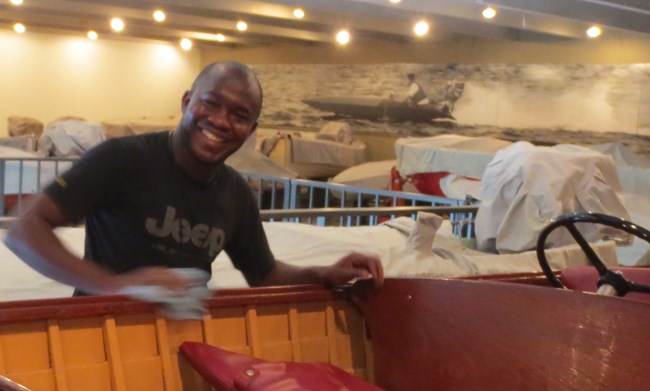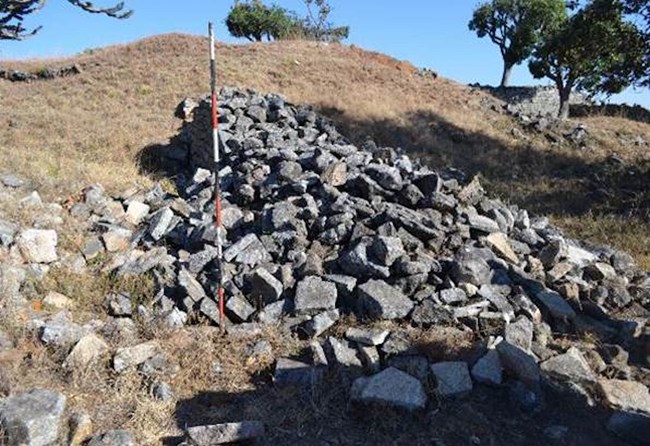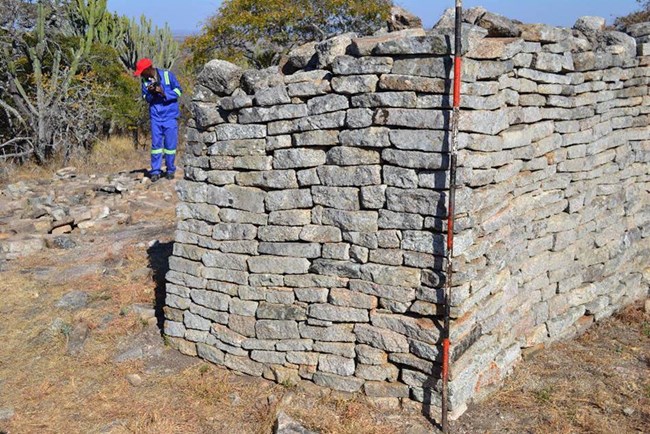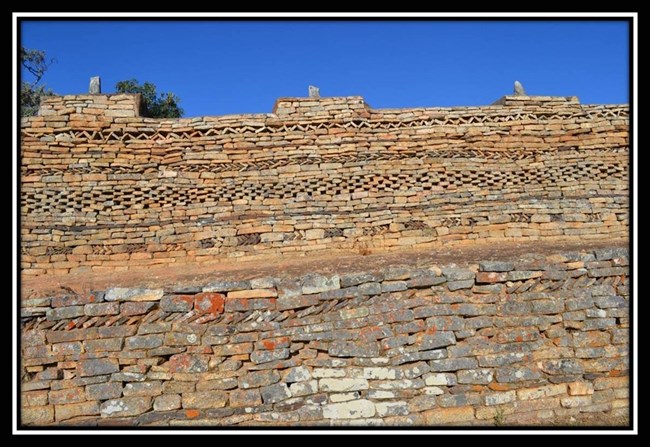Last updated: April 7, 2025
Article
Podcast 073: Museum Studies at Midland State University in Zimbabwe

National Park Service
Dry-Stone Wall Restoration with Davison Chiwara
Davison Chiwara: I work in the department of Archeology, Cultural Heritage and Museum Studies. I mostly specialize on collections management, looking at conservation as a general upkeep of collections in heritage institutions.
The whole group from level one, one up to the fourth level, approximately I can say we have around two hundred students. We have four main disciplines that they’re studying, which are all related, they’re interrelated that is archaeology, cultural heritage management, museum studies, as well as archives and records management.
Jason Church: Now when students leave your university where do they go to work?
Davison Chiwara: Mostly they’re employed in heritage institutions like museums, especially in museums this is the major market that employ our students. They’re also employed in galleries, archival institution, libraries, and even in national parks where there is heritage which is found in most national parks.

Collapsed dry stone wall.
Documentation
Jason Church: Now Davison, you and I met at the Annual AIC Conference-
Davison Chiwara: Yes.
Jason Church: At that conference you were presenting on a project where you and your students were saving dry-stone stacked walls, can you tell us a little bit about that project?
Davison Chiwara: Okay, this project was originally a brain child of the Midland State University, working in collaboration with the Zimbabwe Military Museum which is a museum which falls under the National Museums and Monuments of Zimbabwe.
Davison Chiwara: We came together to restore this monument which was deteriorating. We sought funding from the United States Embassy here in Zimbabwe, and fortunately they came on board and they supported us by funding the restoration exercise, so that’s how we got to work together that is the National Museum and Monuments of Zimbabwe, The Department of Archeology, Cultural Heritage and Museum Studies at Midland State University as well as United States Embassy.
Davison Chiwara: That whole project involved lecturers, students, and museum staff working together. Initially, what we did is we documented the extent of deterioration of the walls and the site, by looking at previous photographs that were taken as well as maps and sketch diagrams. We managed to establish the extent of dilapidation or deterioration of the walls by looking at the collapsed rabbles against what was initially documented on the photographs and sketch maps.
After this documentation exercise then we started the restoration project by restoring the walls following what was captured on the photographs as well as on the maps. These walls were built in the thirteenth century AD. They mostly face problems of wall collapse, which emanates from environmental factors as well as human induced problems.
They have been restored from the years 1937, that is what we got from archival research, whereby the collapsed walls had been restored by previous restorers who were in charge of the monuments then. Then from there on wards there have been ongoing restorations which have been done, but in some cases we have discovered that some of the restorations which were being done were not following the, were not respecting the principles of originality and authenticity of material.
Basically this is what was done before in terms of restoration of the monument. We’re actually taking over from what has been done before.

Davison Chiwara
Deterioration
Jason Church: When you mentioned they did not keep with the original intent of the monument, so what was done to them?
Davison Chiwara: Basically the dry-stone walls structures or the stone walled monuments, they are built using stone without any mortar which is, without any binding mortar between the stone blocks, so that’s why they’re called the dry stone structures.
Davison Chiwara: What was done when restorations were made in 1937, is that they restorers then they introduced cement which is not part and parcel of the original material that were used in the construction of the structures. This addition of cement was against the principles of originality and authenticity.
Jason Church: What sort of factors led to the deterioration of the walls, just age or what other factors?
Davison Chiwara: Yes, yes, we cannot rule out aging as a contributing factor. Then there’s also the issues of biological factors. For instance, termites building mounds on the walls, and those mounds were destabilizing the walls.
Davison Chiwara: We are also talking about any animal, if you still remember my presentation in Miami whereby we’ve got baboons, monkeys causing toppling on some of the walls. As well as the issue of, we do experience tremors, but occasionally maybe once in five or ten years. This shaking of the ground also contributes to destabilization of the walls.
Original Use
Jason Church: What were the walls originally constructed for?

Davison Chiwara
Davison Chiwara: These walls, the homesteads of the elite, the wealth during the thirteenth century AD. They were enclosures from the houses of the elite who were the ruling class during that period. In most cases, some people argue that they were used as defense, they provided security to the people who lived in these homesteads.
We don’t have the original houses, but there are some floors which are found within the walls. Floors, there were also some poles which we discovered, which attest to the point that they were some houses which were build within these wall enclosures.
There are also some artifacts which were found like pottery, beads, and some other artifacts, which were found which show that these walls were actually places of residence from especially the wealth and the ruling class the thirteenth century AD.
Jason Church: Davison, how did you get interested in conservation and preservation?
Davison Chiwara: I think I just got interested when I was a student. We learned about conservation theory, looking at collections management that is particularly looking at environmental control, looking at security to collections. Then after learning that I went for my work related learning period that’s when my interest really developed.
Davison Chiwara: Because during that period I discovered that the issues of conservation were not actually given due consideration in our museum particularly the National Museum of Transport and Antiquities where I went. I discovered that this issue of conservation was given to students who were on work related learning.
Davison Chiwara:In the actual organogram of the organization that is the museum there was no post for a conservator. It was an after thought, I mean the issue of conservation, was just an after thought there was no seriousness in terms of conservation of collections and in terms of the budget that is allocated to the museums very little is given towards the conservation of collections.
Davison Chiwara:Then I just got concerned and inspired about the situation which is currently prevailing in most of the museums in Zimbabwe that’s how I got interested in conservation because in most cases an after thought in our museums and I think something is to be done to ensure that we conserve the collections in our museum.
Davison Chiwara:Currently the situation that is prevailing is not good at all. Our collections are in a sorry stage in most of the museums that I have toured so far.

Davison Chiwara
Students in Collections Conservation
Jason Church: Do you currently have any former students in those museums?
Davison Chiwara: Yes, yes, we do. We have employed some of our former students. We have some colleagues whom I learned with at my university we have been employed by the museum. We’re trying to create networks on conserving collections in museums and galleries with these students who have been employed by these heritage institutions.
Jason Church: What project do you have coming up for your students now that you’ve done the work on the walls what’s next?
Davison Chiwara: Currently I’ve been in touch with one of our former students who is working at the National Art Gallery of Zimbabwe and we would like to embark on a project to conserve photographic documents which found at the gallery. I think this is a project which is yet to commence but it’s in the pipeline that’s the project that I’m thinking about.
In future, if resources permit, I’m sure we’d like to start some conservation projects from collections that are undergoing deterioration particularly here in Gweru at the Zimbabwe Military Museum. I think it’s a project worth doing, because if nothing is done to these collections in the near future we may lose them.
Jason Church: Sounds like you have a very important task ahead of you and your students?
Davison Chiwara: Yes, yes, we’ve got a lot of work to do. Its just that we have problems in harnessing the required resources, harnessing the required conservation technologies which we can use to conserve these collections. In most cases, I think what we’re imparting to our students is theory but we’re linking with the resources that are needed to do hence on conservation work on collections.
Jason Church: We wish you all the luck for you and your students, we hope to hear more from you in the future about about different projects that you’re doing.
Davison Chiwara: Yes, Jason, thank you very much.
Read other Preservation Technology Podcast articles or learn more about the National Center for Preservation Technology and Training.
